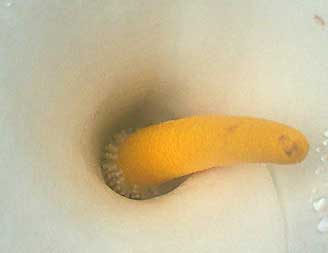Excerpts from Jim Conrad's
Naturalist Newsletter
from the October 15, 2007 Newsletter issued from Yerba Buena Clinic just outside Pueblo Nuevo Solistahuacan, Chiapas, MÉXICO
about 1740 meters in elevation, ± LAT. 17° 11' 27"N, LONG. -92° 53' 35"W
ALCATRAZ OUTSIDE MY WINDOW
Outside my window as I type this, in a garden long abandoned, several plants once planted for the beauty of their flowers have been surviving year after neglected year, and one of them is even flowering. This flower represents a ray of hope in the current rather desperate-seeming situation, so I want to tell you about it. That's it below:

That's the gardener's Calla, ZANTEDESCHIA AETHIOPICA. When you see a fingerlike item emerging from a wrap- around, urn-like thing as in the picture, you should immediately think of that large, mostly-tropical plant family in which you find Jack-in-the-pulpits, arums, anthuriums, philodendrons, caladiums and "Elephants-Ears," the Arum Family, or Araceae. Plants in this family always all have that "Jack" surrounded by or at least subtended by his leafy "pulpit."
The orange-yellow "Jack" in the picture is actually a special kind of flower-spike called a spadix, and the "pulpit" is a special modified leaf called a spathe. On the spadix the actual flowers are tiny, much simplified affairs. The spadix's orange-yellow surface is composed of the male flowers' very closely packed stamens. In this species male flowers occupy the spadix's top part while female ones cluster at the spadix's bottom.

Above is a close-up showing the more widely spaced female flowers, the ovaries, clustering at the spadix's base. Eventually the male section will wither away while the tiny ovaries will enlarge into fruits packed together like the individual juicy bags of a blackberry fruit.
I didn't see too many Callas around Jalpan, though in gardens on moister mountain slopes both above Jalpan and all through central upland Mexico Callas are a garden favorite -- that, despite the fact that originally the species is from South Africa.
Mexicans usually call the plant Alcatraz.